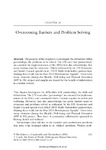Overcoming Barriers and Problem Solving
| dc.contributor.author | Lynch, TJ | en |
| dc.date.accessioned | 2016-10-09T15:03:36Z | |
| dc.date.accessioned | 2016-10-09T15:30:10Z | |
| dc.date.available | 2016-10-09T15:03:36Z | |
| dc.date.available | 2016-10-09T15:30:10Z | |
| dc.date.issued | 2016-07-30 | en |
| dc.identifier.isbn | 3319316664 | en |
| dc.identifier.isbn | 978-3-319-31667-3 | en |
| dc.identifier.other | 10 | en |
| dc.identifier.uri | http://hdl.handle.net/10026.1/6379 | |
| dc.description | This book uses the example of a partnership journey between universities, schools, the local health industry as well as a number of government organisations which worked to ensure the growth of physical education in primary education. The initiative employed the United Nations (UN) ideals as a model and contextualised them within local schools and communities. What began as a pathway seed quickly grew to involve multi-stakeholder partnerships and therefore explores how the UN Sustainable Development Goals (SDG) may be implemented at a grass roots level. | en |
| dc.description.abstract |
The purpose of this chapter is to investigate the difficulties within partnerships, the problems to be solved. The UN state that ‘partnerships’ are essential for implementation of the SDGs but also acknowledge that many barriers must be overcome. This is evidenced by the UN Economic and Social Council special event; ‘2015 Multi-Stakeholder partnerships: Making them work, for the Post 2015 Development Agenda’. There were many obstacles during the Health, Well-being and Physical Education (HW & PE) project and insights are shared for the benefit of stakeholders in a similar context. | en |
| dc.format.extent | 11 | en |
| dc.format.extent | 135 - 148 (14) | en |
| dc.format.medium | e-book & hard cover | en |
| dc.language.iso | en | en |
| dc.publisher | Springer International Publishing | en |
| dc.relation.ispartof | The Future of Health, Wellbeing and Physical Education Optimising Children's Health through Local and Global Community Partnerships | en |
| dc.relation.replaces | http://hdl.handle.net/10026.1/6358 | |
| dc.relation.replaces | 10026.1/6358 | |
| dc.subject | Physical Education | en |
| dc.subject | Health | en |
| dc.subject | Well-being | en |
| dc.subject | Partnerships | en |
| dc.subject | Community | en |
| dc.subject | Collaborations | en |
| dc.subject | Teacher Education | en |
| dc.subject | Social Justice | en |
| dc.subject | Leadership | en |
| dc.subject | Problem Solving | en |
| dc.subject | Sustainable Development Goals | en |
| dc.subject | United Nations | en |
| dc.title | Overcoming Barriers and Problem Solving | en |
| dc.type | Book Chapter | |
| plymouth.author-url | http://www.timothylyncheducation.com/ | en |
| plymouth.edition | 1 | en |
| plymouth.volume | 1 | en |
| plymouth.publisher-url | http://link.springer.com/chapter/10.1007/978-3-319-31667-3_10 | en |
| plymouth.publication-status | Published | en |
| plymouth.series | 2016 | en |
| dc.identifier.doi | 10.1007/978-3-319-31667-3_10 | en |
| plymouth.organisational-group | /Plymouth | |
| plymouth.organisational-group | /Plymouth/Faculty of Arts, Humanities and Business | |
| plymouth.organisational-group | /Plymouth/Faculty of Arts, Humanities and Business/Plymouth Institute of Education | |
| dc.publisher.place | Switzerland | en |
| dc.rights.embargoperiod | No embargo | en |
| rioxxterms.versionofrecord | 10.1007/978-3-319-31667-3_10 | en |
| rioxxterms.licenseref.uri | http://www.rioxx.net/licenses/all-rights-reserved | en |
| rioxxterms.type | Book chapter | en |
| plymouth.oa-location | http://www.palgrave.com/de/book/9783319316666 | en |


